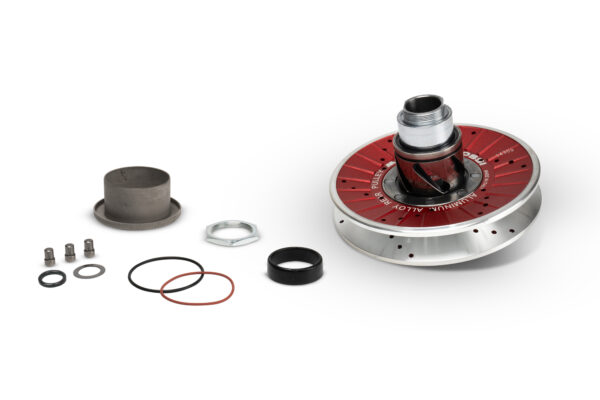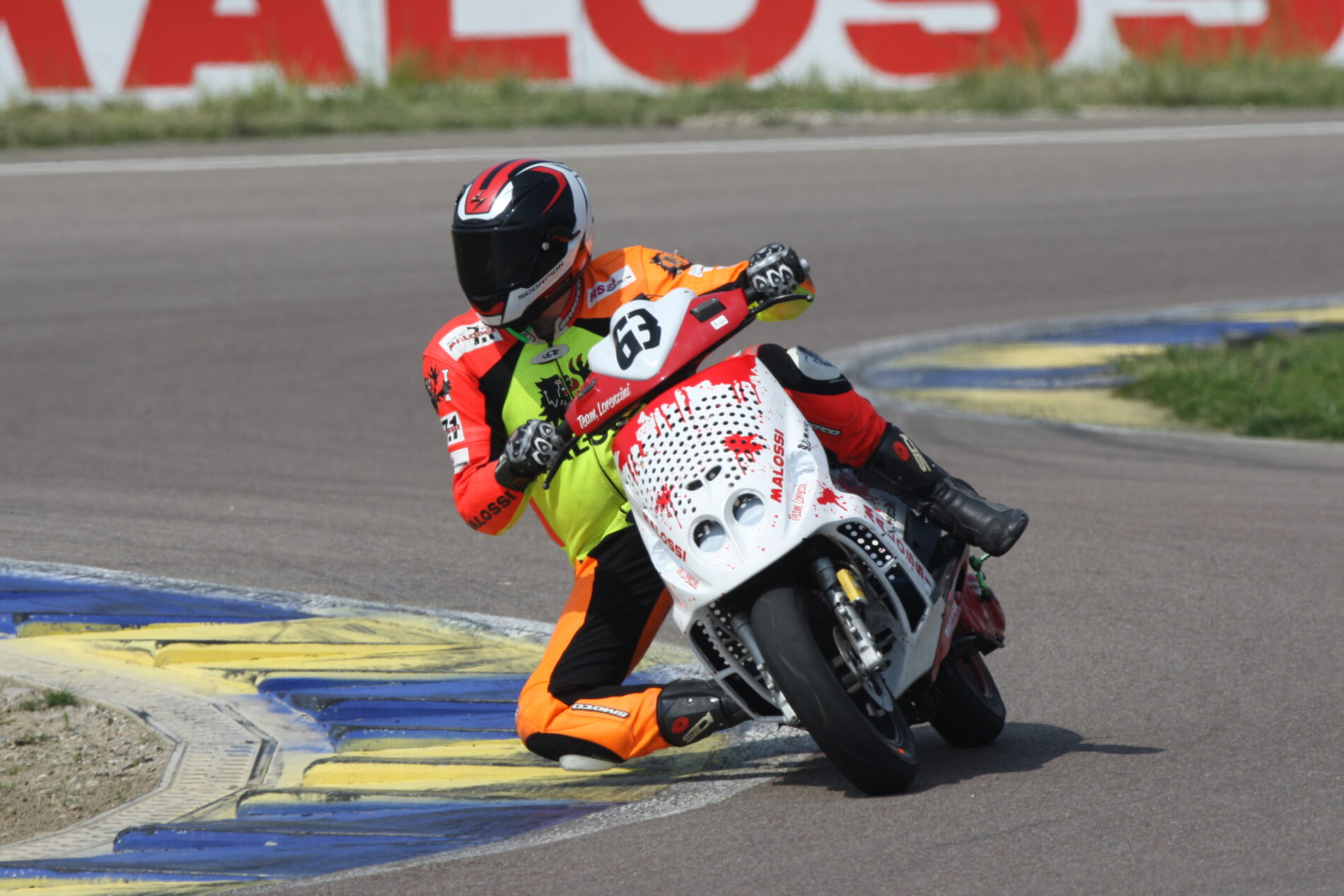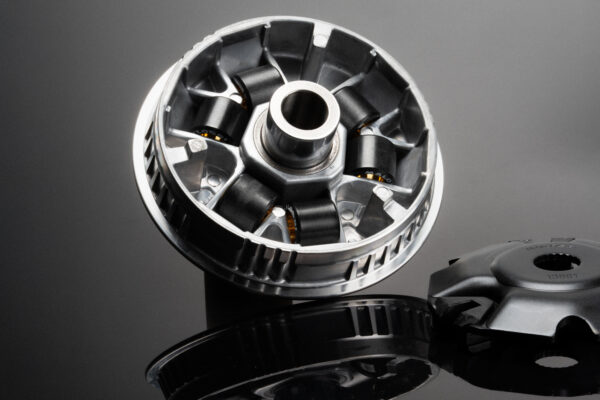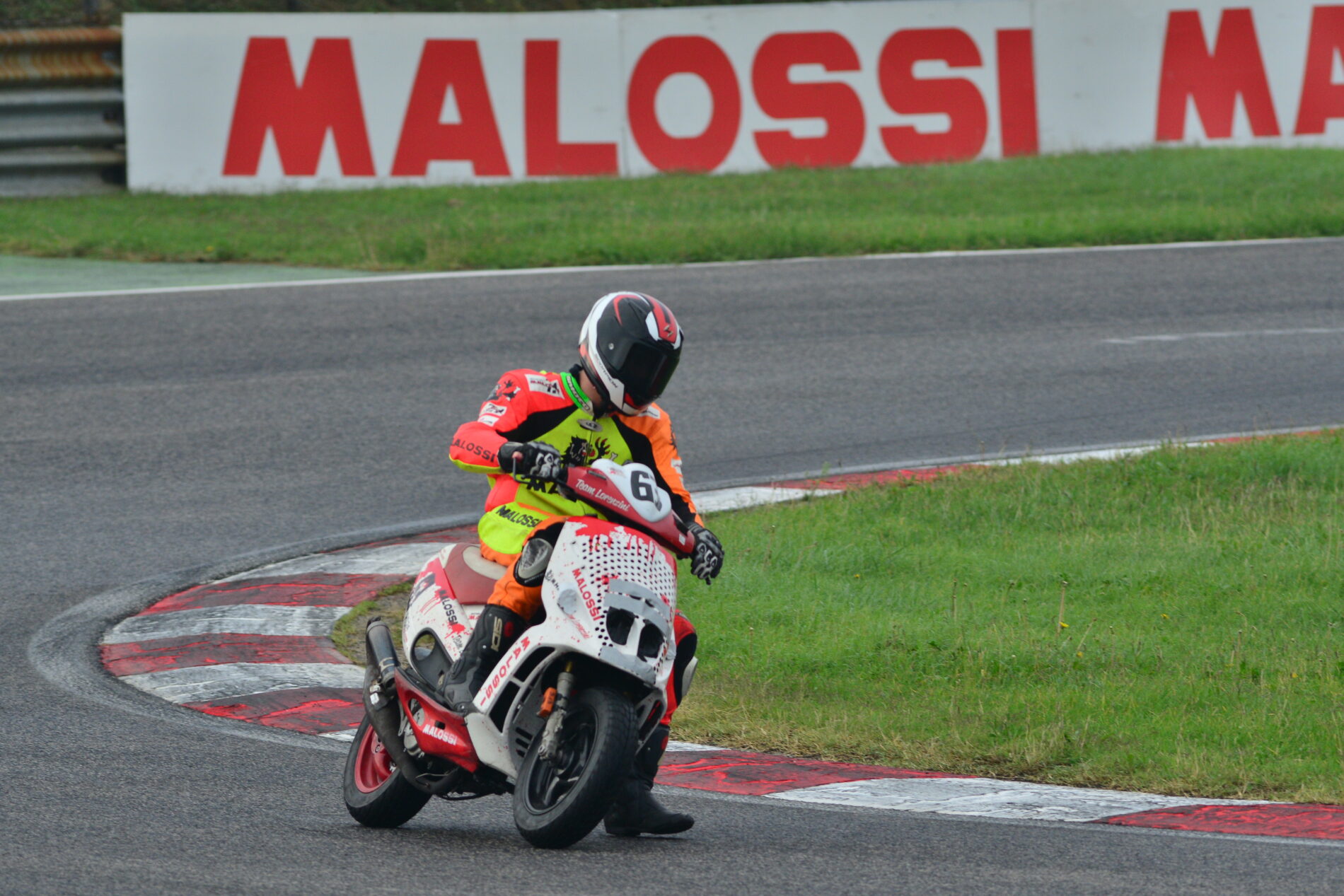
It’s 1994, “The Rhythm of the Night” is blasting out on the radio, and the streets are packed with MBK Boosters. No-one is expecting the arrival of the Phantom F12: Malaguti already has the F10 in its catalogue – which is starting to show its age – so the dynamic Emilia-Romagna-based brand decides to launch a new model that will surely turn out to be a huge success: the avioscooter.
Its sharp, streamlined lines combined with aggressive air intakes resemble a fighter jet taking a dive, but it’s not just the aesthetics that turn teenagers’ heads. The Phantom F12 boasts top-tier chassis quality thanks to its multi-adjustable Paioli suspension and low-profile tires, while the engine wins over riders for its performance and fuel economy, which was significantly improved in 1995 with the adoption of liquid cooling. Its handling on the road lives up to its look: aggressive, nimble, and lightweight.
In the middle of all this buzz, Malossi quickly answered the question: “how do you boost the performance of a Phantom F12?”, supporting those who owned one at the time and customised it in every possible way, starting with eyelid covers for the headlights.
And what about those who didn’t own a Phantom F12? They definitely looked on with admiration at those who did.
Performance of the Phantom F12
As proof of the quality of the project, the Phantom F12 had an impressively long lifespan for a scooter, as it was produced until 2011. Over the years, it was constantly improved and upgraded. First, as mentioned, with liquid cooling, then in 1997 with the rear disc brake, and later through digital instrumentation, along with a series of minor aesthetic and technical refinements.
Phantom F12 50 cc: Born for Fun
Despite being bound by the limits of the Highway Code, the 50 cc version has a zippy, peppy character on acceleration, perfect for city riding, just like its 100 cc sibling. Moving on to the four-stroke versions, the 200 and 250 cc are noticeably more powerful than the 125 cc.
Phantom F12 100 cc: How it Stands Out
The Phantom F12 100 cc boasts 10.5 HP and doesn’t set records in its category, but it features a catalysed Franco Morini engine that’s powerful and equipped with a very robust transmission — definitely well worth a mention. This, combined with its dimensions being practically identical to the 50 cc, makes it a true little beast in city traffic.
Phantom F12 125 cc: Flat Emotions
The 125 cc performance is sleepy, powered by a smooth and linear Minarelli engine, though not particularly engaging, partly due to a clutch that’s not perfectly calibrated. That said, above 7000 RPM, you can feel the pull of its claimed 13.5 HP, which faintly echo the liveliness of the two-stroke engines that made us fall in love with the avioscooter in the first place.
Phantom F12 Max 200 cc
Phantom F12 Max 200 cc features a declared 19.7 HP and a chassis well-suited for curves. This version was marketed with significant optional accessories, such as the Motorguard Alarm electronic anti-theft system, luggage rack for out-of-town trips, a top case, a windscreen, and a scooter cover. This time, the engine is a 198 cc Piaggio unit with a single overhead camshaft and 4 valves. In terms of frame and chassis, it differs very little from the other models in the Max series.
The quarter-liter Malaguti version stays true to the avioscooter spirit, meaning the Bolognese company chose to maintain the same agility and extreme maneuverability as its smaller siblings, creating a scooter that clearly favours the city as its hunting ground, rather than long highway journeys. Although the engine capacity would certainly allow for them.
As for the engine, it proves to be both lively and capable, thanks to its 21.8 HP and especially the 20 Nm of torque reached just below 7000 rpm. Moreover, as everyone knows: the combination of a punchy engine, lightweight frame, and compact size is the best ticket to the heart of anyone seeking a nimble, responsive, and high-performing scooter. In a word, thrilling.
Phantom F12 Engine Options
Let’s take a quick recap: the Phantom F12 was first launched with a 50 cc engine, followed a few years later by the 100 cc version, and then by several Phantom Max models (125, 200, 250 cc), all of which featured four-stroke engines and reinforced frames.
In the latest versions of the 50 cc model, to comply with Euro 1 and Euro 2 regulations, several emissions-reducing systems were introduced: the ignition system was upgraded, and an idle fuel mixture regulator was added, along with a Throttle-Position Sensor (TPS) and an ECU to manage ignition timing.
The instrument cluster became fully digital as from 2001.
Over the years, Malaguti has released several special editions and variants of the Phantom F12, some of which featured slightly more powerful engines or unique technical specs:
- Phantom F12R with a revamped look, improved engine, and better suspension;
- Limited and Racing Editions, featuring race-inspired liveries and often equipped with aftermarket parts to boost performance, some with custom airbrushed paintwork and limited editions tailored for collectors and enthusiasts alike.
Phantom F12LC: the Liquid Cooling Breakthrough
The Phantom F12 LC (Liquid Cooled) is one of the most advanced, high-performing versions of the Malaguti Phantom F12. This model introduced liquid cooling, bringing significant improvements in performance and reliability compared to the air-cooled versions. As mentioned earlier, it was launched in 1995, and remained in production until the early 2010s, during which the Phantom F12 LC underwent several makeovers in order to remain competitive and compliant with CO2 emission regulations.
Its success undoubtedly stems from its superior performance compared to the air-cooled variants, especially its ability to maintain consistent power output, at approx. 4–5 HP, ideal for a 50 cc scooter. Plus, the water-cooling system eliminates the power loss caused by forced-air cooling fans.
On top of that, the throttle response is sharp and immediate—making the Phantom F12 LC an absolute blast to ride.
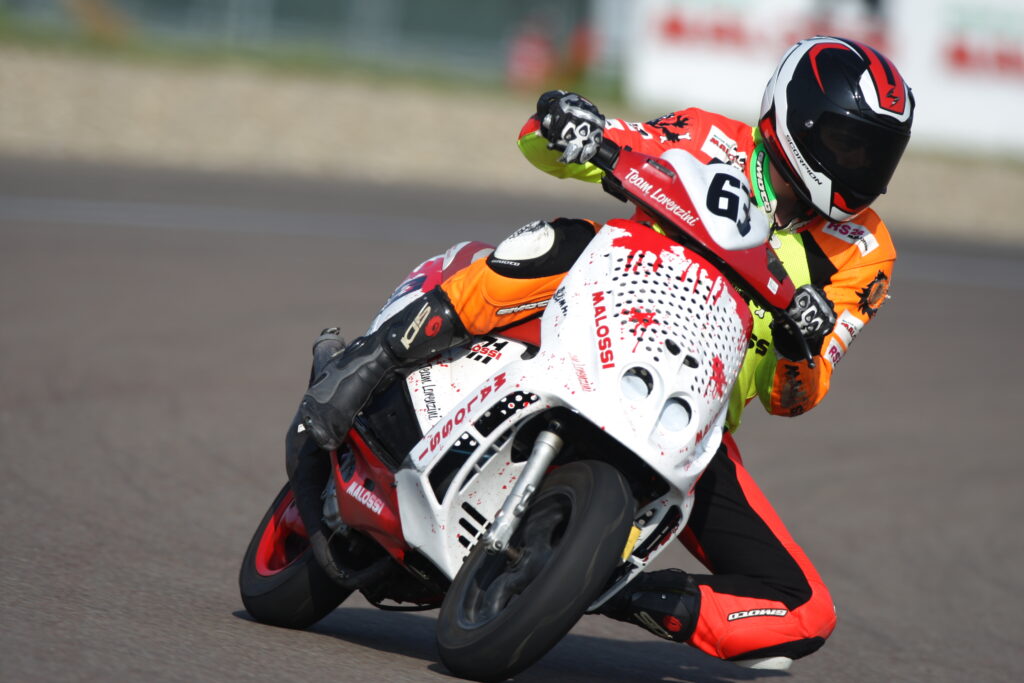
Until 1998, the rear brake was still a drum, but from that year onwards, it was replaced with a disc brake, just like at the front, offering greater safety and enhanced braking power.
Satisfaction with the LC version was so high that, from that moment onwards, all F12 models featured liquid cooling and dual disc brakes (front and rear).
Phantom F12 R
The Phantom F12 R was marketed by Malaguti starting in 2006. This variant continues to use a two-stroke 50 cc engine but introduced several innovations both aesthetically and technically, further consolidating the reputation of the “avioscooter” as one of the best scooters for young riders.
The design of the F12 R was revamped to be even more modern and eye-catching. Its lines are more aggressive and sporty, with particular attention given to detail:
- The front headlights were redesigned to offer better lighting and a more modern, aggressive look.
- The bodywork was improved to provide more aerodynamic efficiency, reduce air resistance, and enhance performance.
- The dashboard is fully digital, providing the rider with all the necessary information clearly and immediately.
The Phantom F12 R’s suspension system was also upgraded to deliver a more comfortable and stable ride:
- At the front, there’s a hydraulic telescopic fork that offers excellent shock absorption and precise handling.
- The rear suspension features a single adjustable shock absorber, allowing the rider to fine-tune the suspension response to suit riding needs and road conditions.
How much fuel does a Phantom F12 consume?
The fuel consumption of the Phantom F12, like any other two- or four-wheeled vehicle, undoubtedly also depends on your driving style. However, we can still assess the efficiency and practicality of this legendary scooter by briefly reviewing each engine version.
The base model of the avioscooter offers good acceleration and adequate power for urban use. Two-stroke engines are known to consume slightly more fuel than four-stroke engines, but they make up for it with lively performance. The average fuel consumption of the Phantom F12 50 cc is around 20–25 km/l. The tank capacity is approximately 9.5 litres, which means a range of about 190–237 km on a full tank.
In short, it’s ideal for short urban trips and for young riders looking for an affordable, fun vehicle.
The 100 cc version of the Phantom F12 reports an average fuel consumption of around 25–30 km/l, with a tank capacity of about 9.5 litres. This translates into a range of approximately 225–270 km on a full tank: the Phantom F12 100 cc is an interesting choice for those who want a vehicle that’s handy for both urban use and slightly longer trips.
The Phantom F12 125 cc is the first of the Max series to use a four-stroke engine, which offers greater fuel efficiency compared to two-stroke engines, although it’s less fun to ride. When well tuned, it records an average consumption of about 25–30 km/l and, with a tank capacity of around 9–10 litres, it ensures a range of about 225–270 km. It’s ideal for those looking for a versatile scooter, capable of handling urban traffic and short out-of-town trips with ease.
With the 200 cc, we see a significant increase in power, thanks to a larger displacement four-stroke engine. This model is designed for those looking for high performance and who want to tackle more demanding routes. The average fuel consumption of the Phantom F12 200 cc is about 20–25 km/l, with a tank capacity of around 10 litres. This translates to a range of approx. 200–250 km on a full tank.
The F12 250 cc, the big brother of all Phantom F12 models – both in terms of power and performance – offers a very satisfying riding experience, capable of handling even medium to long trips with ease. Its average consumption is around 30 km/l on highways and 25 km/l in the city, with a fuel tank capacity of about 12 litres, meaning it delivers a range of approximately 180–240 km on a full tank.
At Malossi, we remember perfectly the unmistakable roar of the avioscooter, its unique style, as well as the adventures lived in its company. This is a Made in Italy scooter that truly made history, it still fascinates us to this day, and can make anyone who still has a Phantom F12 in their garage extremely happy.
